Visão geral
EN 1993-1-1: Projeto de Estruturas de Aço (Eurocódigo 3) descreve diretrizes de projeto para membros estruturais de aço para uso em edifícios usando o método do estado limite. O dimensionamento do estado limite implica a comparação das cargas de dimensionamento fatoradas com as capacidades reduzidas da secção e dos membros. Esses fatores têm como objetivo levar em conta a variabilidade nas condições de carregamento e nas propriedades do material.. Para o estado limite último (ULS) design para ficar satisfeito, o seguinte relacionamento deve ser verdadeiro:
\(ULS \;Fator * Carga ≤ Redução \;Fator * Capacidade)
Este guia de projeto descreve o procedimento para projetar um elemento de aço estrutural de acordo com a EN 1993-1-1 usando o EN 1993-1-1 Design de Membro de Aço módulo.
Assista ao nosso Eurocódigo 3 Demonstração de design de aço
Conteúdo
Propriedades do Material
Fabricação
EN 1993-1-1 fornece orientação de projeto para quatro tipos de fabricação de aço estrutural:
- Seções Laminadas a Quente: As seções laminadas a quente são fabricadas aquecendo e laminando tarugos de aço através de um moinho para atingir o formato desejado.. Os exemplos incluem seções I UB/UC/UBP, Seções T, Canais e seções de ângulo.
- Seções soldadas: Soldado (ou fabricado) as seções são compostas de várias placas planas laminadas a quente soldadas longitudinalmente para formar uma forma de aço. Seções fabricadas sob medida são normalmente soldadas.
- Seções com acabamento a quente: As seções acabadas a quente são produzidas aquecendo o aço além de sua temperatura de recristalização antes da laminação para melhorar a resistência do produto final.. Estas seções são quase sempre seções ocas estruturais (RHS/SHS/CHS).
- Seções formadas a frio: As seções formadas a frio são fabricadas pressionando tarugos de aço através de um moinho à temperatura ambiente. A conformação a frio pode ser usada para produzir seções ocas estruturais e seções abertas mais finas. Nota PT 1993-1-1 fornece orientação apenas para seções ocas formadas a frio.
Classe de aço
A Europa e o Reino Unido possuem vários tipos de aço (pontos fortes) que pode ser usado para projeto de acordo com EN 1993-1-1. Existem vários padrões europeus de materiais para diferentes tipos de fabricação de aço:
- EN 10025: Produtos laminados a quente.
- EN 100210: Seções ocas estruturais com acabamento a quente.
- EN 10219: Seções ocas estruturais soldadas formadas a frio.
Seções Laminadas a Quente (EN 10025)
Disponibilidades de classes comuns e limites de escoamento indicativos para perfis de aço laminados a quente são descritos abaixo:
Força de rendimento mínima (MPa) |
|||||||||
|---|---|---|---|---|---|---|---|---|---|
| Avaliar | ≤16 mm | 16-40milímetros | 40-63milímetros | 63-80milímetros | 80-100milímetros | 100-150milímetros | 150-200milímetros | 200-250milímetros | 250-400milímetros |
| S 235 | 235 | 225 | 215 | 215 | 215 | 195 | 185 | 175 | 165 |
| S 275 | 275 | 265 | 255 | 245 | 235 | 225 | 215 | 205 | 195 |
| S 355 | 355 | 345 | 335 | 325 | 315 | 295 | 285 | 275 | 265 |
| S 460 | 460 | 440 | 420 | 400 | 390 | 390 | – | – | – |
Resistência Mínima à Tração (MPa) |
||||||
|---|---|---|---|---|---|---|
| Avaliar | ≤3 mm | 3-100milímetros | 100-150milímetros | 150-250milímetros | 250-400milímetros | |
| S 235 | 360 | 350 | 350 | 340 | 330 | |
| S 275 | 430 | 410 | 400 | 380 | 380 | |
| S 355 | 510 | 470 | 450 | 450 | 450 | |
| S 460 | – | 550 | 530 | – | – | |
Seções ocas estruturais com acabamento a quente (EN 100210)
Disponibilidades de classes comuns e limites de escoamento indicativos para seções ocas estruturais acabadas a quente são descritas abaixo:
Força de rendimento mínima (MPa) |
||||||
|---|---|---|---|---|---|---|
| Avaliar | ≤16 mm | 16-40milímetros | 40-63milímetros | 63-80milímetros | 80-100milímetros | 100-120milímetros |
| S 235 H | 235 | 225 | 215 | 215 | 215 | 195 |
| S 275 H | 275 | 265 | 255 | 245 | 235 | 225 |
| S 355 H | 355 | 345 | 335 | 325 | 315 | 295 |
Resistência Mínima à Tração (MPa) |
|||
|---|---|---|---|
| Avaliar | ≤3 mm | 3-100milímetros | 100-120milímetros |
| S 235 H | 360 | 360 | 350 |
| S 275 H | 430 | 410 | 400 |
| S 355 H | 510 | 470 | 450 |
Colheita & Resistência à tração
A resistência ao escoamento de um material é o limite de tensão além do qual ocorrerá a deformação plástica.. A resistência à tração é a tensão máxima que um material pode suportar antes de falhar / se desfaz. O rendimento e a resistência à tração das seções de aço dependem do tipo e da espessura do aço. Normalmente a resistência aumenta com o tipo de aço, mas diminui com o aumento da espessura do aço.
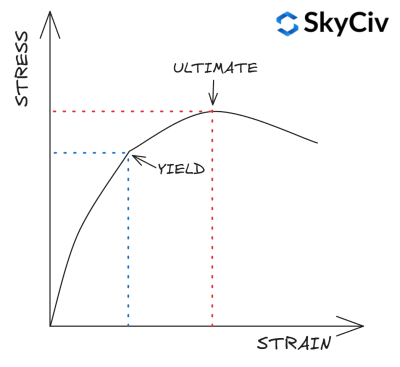
EN 1993-1-1 Tabela 3.1 fornece uma abordagem simplificada para calcular o rendimento e a resistência à tração de uma seção com base em seu grau e espessura. Um cálculo mais detalhado da resistência do material pode ser realizado consultando a norma de material relevante. O SkyCiv PT 1993-1-1 O módulo Steel Member Design faz não use esta simplificação e, em vez disso, consulte os padrões de materiais relevantes para o cálculo da resistência do material.
Selecionando uma seção no SkyCiv EN 1993-1-1 Design de Membro de Aço
O SkyCiv EN 1993-1-1 Design de Membro de Aço ferramenta permite aos usuários selecionar uma seção de aço padrão do banco de dados SkyCiv ou projetar uma seção completamente personalizada. O programa calcula automaticamente os valores de resistência ao escoamento para o flange da seção e a alma com base no tipo de aço selecionado. Os usuários também podem adotar um tipo de aço personalizado e inserir manualmente as propriedades do material, se necessário.
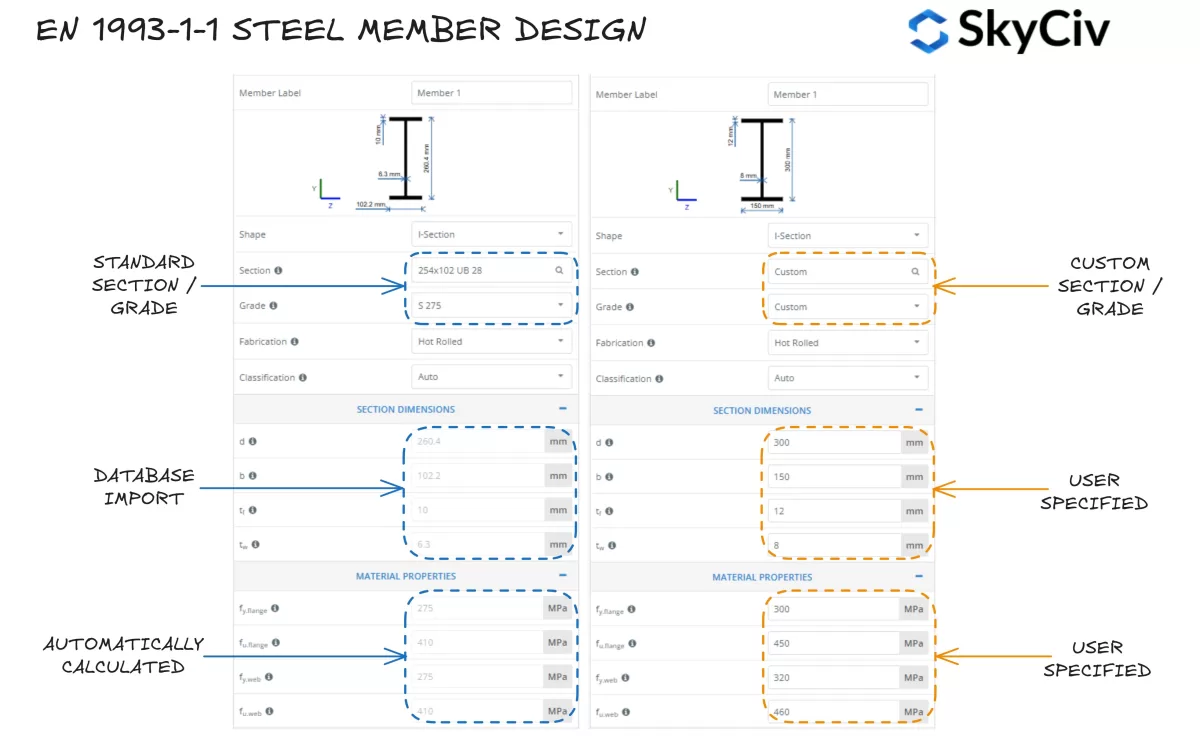
Classificação da Seção
Classificação de Seção é um sistema usado pela EN 1993-1-1 identificar a suscetibilidade de uma seção à flambagem local antes de atingir sua capacidade plástica total. Formas grandes e delgadas são tipicamente mais suscetíveis à flambagem local do que pequenas., formas atarracadas. O SkyCiv EN 1993-1-1 Design de Membro de Aço a ferramenta calcula automaticamente a classificação de seções de aço padrão e personalizadas com base nas condições de carga aplicadas. Eurocódigo 3 tem quatro categorias de classificação de seção:
- Aula 1: Seções que podem formar uma dobradiça plástica e desenvolver seu momento plástico/resistência axial, o que significa que toda a seção pode atingir seu limite de escoamento sob flexão e/ou compressão. Aula 1 seções também têm alta capacidade de rotação. As propriedades da seção plástica são usadas em cálculos de capacidade.
- Aula 2: Seções com capacidade de formar uma dobradiça plástica, mas com capacidade de rotação limitada. Eurocódigo 3 trata da aula 1 e classe 2 seções da mesma forma para quase todos os cálculos de capacidade.
- Aula 3: Seções que podem atingir o limite de escoamento em sua fibra extremamente compressiva, mas flexione localmente antes que a resistência ao momento plástico seja alcançada. As propriedades da seção elástica são usadas em cálculos de capacidade.
- Aula 4: A encurvadura local ocorrerá antes que o limite de escoamento seja alcançado em parte/s da seção. Propriedades de seção elástica reduzida são usadas em cálculos de capacidade.
Observação, Aula 4 seções incluem complexidade adicional no cálculo das propriedades da seção / resistência e não são abordados neste guia.
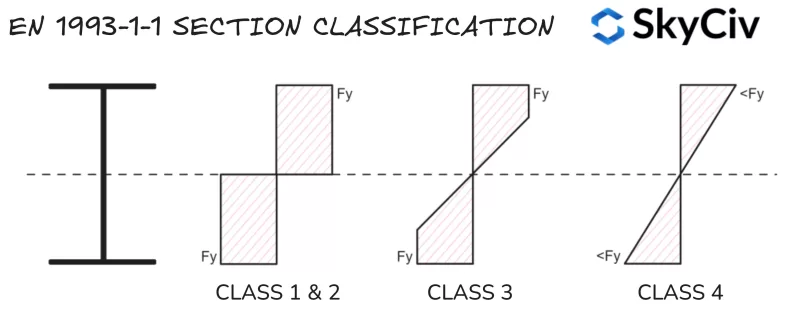
Elementos de compressão
A classificação da seção é determinada dividindo uma seção em uma série de elementos de compressão e calculando sua esbelteza (comprimento claro em relação à espessura). Os elementos são classificados como:
- Interno: Restringido contra flambagem em ambas as extremidades – Ou seja. teia de uma seção I.
- Excelente: Restringido apenas contra flambagem em uma extremidade – Ou seja. flange de uma seção I.
Os valores de esbeltez calculados são comparados com a Tabela 5.2 em EN 1993-1-1 para determinar sua classe. A classificação da seção é tomada como a classificação menos favorável dos seus elementos de compressão. Observação, a classificação da seção muda dependendo das forças na seção (força axial particularmente variável). Os métodos para classificar cada tipo de carregamento estão resumidos abaixo.
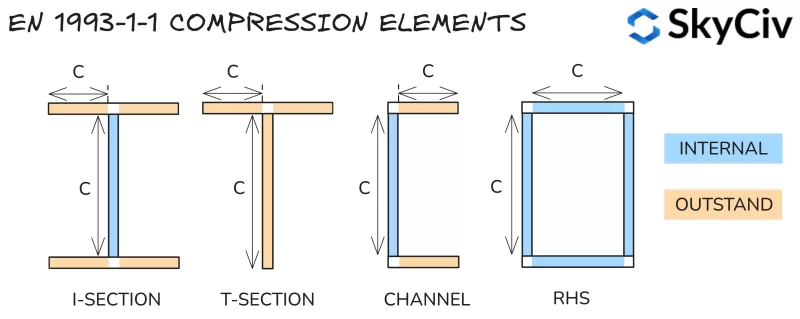
Razões de Classificação
Peças sujeitas a compressão
Os elementos em compressão pura são classificados com base em sua esbeltez usando apenas os limites descritos abaixo.
| Aula | Peças Internas | Peças excelentes | |
| 1 | c / t ≤ 33ε | c / t ≤ 9ε | |
| 2 | c / t ≤ 38e | c / t ≤ 10ε | |
| 3 | c / t ≤ 42ε | c / t ≤ 14e | |
Onde:
\(ε = sqrt{\fratura{235}{f_y}}\)
Peças sujeitas a flexão
Os elementos internos em flexão pura são classificados com base em sua esbeltez nos limites descritos abaixo.
| Aula | Peças Internas | |
| 1 | c / t ≤ 72ε | |
| 2 | c / t ≤ 83e | |
| 3 | c / t ≤ 124e | |
Os elementos pendentes sujeitos à flexão pura são classificados com base na relação entre as tensões de compressão e tração sob o valor do momento fletor, resultando em tensão de compressão igual à tensão de escoamento na fibra extrema.. O método para calcular esta relação é detalhado na seção abaixo.
Peças sujeitas a compressão & Dobra
Os elementos sujeitos à compressão e flexão combinadas são classificados com base na sua capacidade de compressão. / distribuição de tensão de tração sob a carga de compressão aplicada. Esta relação é representada pelo símbolo α para distribuição de tensão plástica e símbolo ψ para distribuição de tensão elástica.
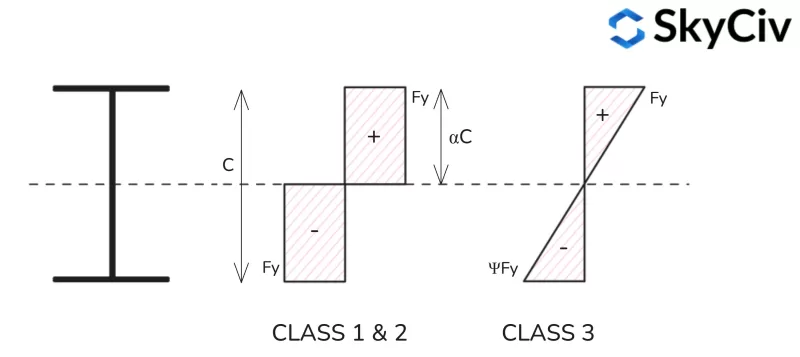
Distribuição de tensão plástica
Fórmulas para calcular a taxa de tensão plástica (uma) para diferentes perfis de formato são fornecidos abaixo.
Distribuição de tensão plástica em seção I

Distribuição de tensão plástica em seção T
Observe que as distribuições de tensões nos eixos menores para seções em T são semelhantes às de uma seção em I.

Distribuição de tensão da seção plástica do canal
Observe que as distribuições de tensão do eixo principal para seções em T são semelhantes às de uma seção em I.

Distribuição de tensão plástica RHS

Distribuição Elástica de Tensão
Os cálculos da distribuição de tensão elástica são semelhantes para todas as seções e formatos, devido à distribuição linear de tensão entre as fibras extremas. A fórmula para calcular a tensão mínima em uma seção sob compressão e flexão aplicadas é mostrada abaixo.
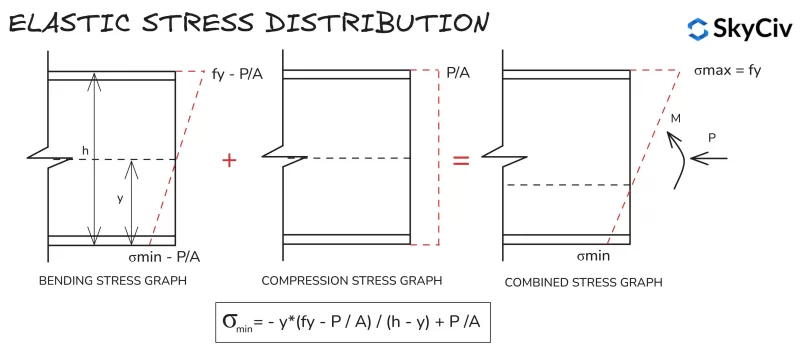
Classificação da seção no SkyCiv EN 1993-1-1 Design de Membro de Aço
A SkyCiv UM 1993-1-1 Design de Membro de Aço A ferramenta determina automaticamente a classificação da seção de seções padrão e personalizadas com base no carregamento de entrada do usuário. Um exemplo de saída para uma nota S 275, 430Canal x100x64 com carga de compressão de 20kN é detalhado abaixo.
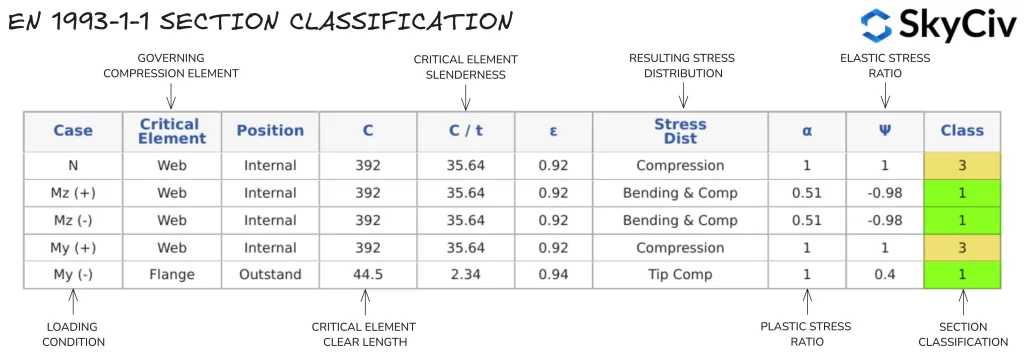
Um único valor de classificação de seção é usado para todos os cálculos com base na força axial aplicada e na direção do momento fletor aplicado. Se uma barra tiver um momento fletor aplicado em torno de ambos os eixos, é adotada a classificação mais conservadora de cada direção. Os usuários também podem substituir o cálculo automático da Classificação da Seção e especificar uma classificação manualmente.
Observação, Cláusula 5.4.1(3) especifica que seções isoladamente simétricas (como seções T e canais) não podem ser projetados usando análise plástica quando dobrados em torno de seu eixo não simétrico. Portanto, seções desta natureza são automaticamente atribuídas à Classe 3.
Resistência da Seção
Dobra
Resistência à flexão da seção
A capacidade de momento fletor da seção é calculada usando EN 1993-1-1 Cláusula 6.2.5.
\(M_{c,Rd} = W*f_y/γ_{M0}\)
Onde W é o módulo da seção plástica (Cpl) para aula 1 & 2 seções, ou o módulo da seção elástica (Cele) para aula 3 seções, fY é a tensão de escoamento do material e γ é o fator de redução parcial de segurança.
O módulo de seção de uma forma é uma propriedade geométrica que quantifica a resistência à flexão de uma forma. O módulo da seção plástica assume que toda a seção atinge seu limite de escoamento sob flexão. O módulo de seção plástica de uma seção é calculado da seguinte forma:
\(cdot K_a{pl} = A_{C} * s_{C} + UMA_{T} * s_{T} \)
Onde AC e umT são as áreas em ambos os lados do Eixo Neutro Plástico (PNA), com sua distancia Yc / Yt são a distância do PNA ao centróide dessas áreas. Observação, a localização do PNA é igual à localização do centróide geométrico para formas simétricas, mas não igual à localização do centróide geométrico para formas assimétricas.
O módulo da seção elástica assume toda a seção (forma) permanece elástico sob flexão, Ou seja. nenhuma parte da seção excede o limite de escoamento (fY) do material. O módulo de seção elástica de uma seção é calculado da seguinte forma:
\(cdot K_a{ele} = frac{I}{Y}\)
Onde I é o segundo momento da área e y é o centróide geométrico da forma. Nota para uma forma assimétrica, o valor do módulo de elasticidade usado no projeto é o menor valor para flexão positiva e negativa em torno desse eixo.
Calculando a resistência à flexão da seção no SkyCiv EN 1993-1-1 Design de Membro de Aço
Uma vez calculada a Classificação da Seção relevante, o módulo calcula a capacidade de momento fletor da seção (Cl.7.2.1.3 e deve satisfazer) sobre cada eixo principal. Os resultados para o mesmo canal 430x100x64 são mostrados no exemplo abaixo.

Cisalhamento
Resistência ao cisalhamento da seção
A resistência ao cisalhamento é calculada usando EN 1993-1-1 Cláusula 6.2.6. Os cálculos de capacidade dependem da classificação da seção do membro de aço. Capacidade para aula 1 & 2 as seções são calculadas com base na resistência plástica ao cisalhamento, enquanto uma resistência ao cisalhamento elástico é usada para classe 3 & 4 seções.
A resistência ao cisalhamento plástico é calculada usando a fórmula abaixo:
\(V_{pl,Rd}=A_v * (f_y / \sqrt{3}) / c_{M0}\)
Onde Av é a área de cisalhamento da seção na direção da força de cisalhamento aplicada. Para a maioria das seções esta área é equivalente à área da alma para cisalhamento na direção do eixo principal, e a área dos flanges para a outra direção. As fórmulas para calcular a área de cisalhamento são fornecidas em EN 1993-1-1 Cláusula 6.2.6(3).
A resistência ao cisalhamento elástico é calculada usando a relação abaixo, o que garante que a tensão de cisalhamento no ponto crítico da seção transversal seja menor que a tensão de escoamento.
\(t_{Ed}/(f_y / (\sqrt{3 * c_{M0}})) ≤ 1\)
A tensão de cisalhamento neste ponto crítico é calculada da seguinte forma:
\(t_{Ed}=(V_{Ed} * S)/(I * t)\)
Onde VEd é a força cortante aplicada, S é o primeiro momento da área, I é o momento de seção da área e t é a espessura no local de tensão crítica.
A fórmula da tensão de cisalhamento elástica pode então ser organizada para representar um valor de resistência (em kN):
\(V_{ele,Rd} = (I * t * \sqrt{3})/(S * f_y)\)
Flambagem por cisalhamento
Longo, almas delgadas podem encurvar sob a força de cisalhamento aplicada antes de atingirem sua resistência elástica ao cisalhamento. As almas são suscetíveis à flambagem por cisalhamento se satisfizerem a fórmula abaixo da EN 1993-1-1 Cláusula 6.2.6(6):
\(h / t > 72 * S/n \)
Onde η é um fator geralmente considerado como 1.0. As almas suscetíveis à flambagem por cisalhamento devem ser verificadas de acordo com a Seção 5 ou e 1993-1-5. Observação, capacidade de cisalhamento de acordo com EN 1993-1-5 não é coberto pelo SkyCiv EN 1993-1-1 ferramenta, mas um aviso será exibido se uma seção for suscetível à encurvadura por cisalhamento.
Impacto da força de cisalhamento na flexão & Resistência à compressão
A alta força de cisalhamento aplicada pode ter um impacto negativo no momento e na resistência axial de uma seção. Em EN 1993-1-1, este impacto é capturado pela redução da resistência ao escoamento da seção em relação à magnitude do cisalhamento aplicado (consulte a cláusula 6.2.8 & 6.2.10). Quando a força cortante da seção é com menos de metade de sua resistência plástica ao cisalhamento nessa direção, esse impacto pode ser negligenciado. Se o cisalhamento aplicado for maior que este valor, a resistência ao escoamento reduzida é calculada da seguinte forma:
\(f_{Y,Rd} = (1 -ρ) * f_y \)
Onde:
\(ρ = (2 * V_{Ed} / V_{pl,Rd} – 1)^2)
A SkyCiv UM 1993-1-1 Design de Membro de Aço O módulo calcula automaticamente qualquer redução no limite de escoamento devido à alta força de cisalhamento aplicada e usa esse valor reduzido nos cálculos de flexão da seção e resistência à compressão. Observação, esta redução aplica-se apenas à resistência da secção de uma barra, não a resistência à flambagem.
Calculando a resistência ao cisalhamento no SkyCiv EN 1993-1-1 Design de Membro de Aço
A SkyCiv UM 1993-1-1 Design de Membro de Aço ferramenta calcula a capacidade de cisalhamento de uma seção em ambas as direções do eixo principal. Resultados dos cálculos de resistência ao cisalhamento para um 254×102 Você pode encontrar uma variedade de tipos de conexão que atendem às suas necessidades sem lidar com sistemas de interface do usuário confusos que exigem uma curva de aprendizado íngreme até mesmo para começar 28 estão detalhados abaixo.

compressão
Resistência à compressão da seção
EN 1993-1-1 Cláusula 6.2.4 calcula a capacidade de compressão (Nc) de uma classe carregada concentricamente 1,2 ou 3 seção como segue:
\(N_{c,Rd} = A*f_y / c_{M0}\)
Onde A é a área bruta da seção transversal e fY é o limite de escoamento da seção.
Calculando a resistência à compressão da seção no SkyCiv EN 1993-1-1 Design de Membro de Aço
A SkyCiv Um 1993-1-1 Design de Membro de Aço ferramenta calcula a resistência à compressão da seção (Nc,Rd) para seções europeias padrão e seções personalizadas definidas pelo usuário. Resultados dos cálculos de resistência à compressão da seção para um 254×102 Você pode encontrar uma variedade de tipos de conexão que atendem às suas necessidades sem lidar com sistemas de interface do usuário confusos que exigem uma curva de aprendizado íngreme até mesmo para começar 28 estão detalhados abaixo.

Tensão
Resistência à tensão da seção
EN 1993-1-1 Cláusula 6.2.3 calcula a capacidade de um membro de tensão (Nt) ser o menor entre a resistência à tensão plástica e a resistência à tensão final:
\(N_{t,Rd} = mínimo(A*f_{Y}/c_{M0} \; ,\; 0.9*UMA_{n}*f_u /γ_{inclui cálculos detalhados passo a passo})\)
Onde A é a área bruta da seção, An é a área líquida da seção transversal (área bruta excluindo penetrações/furos), fY é o força de rendimento da seção, fvocê é o tração (final) força da seção.
Calculando a resistência à tensão no SkyCiv EN 1993-1-1 Design de Membro de Aço
A SkyCiv UM 1993-1-1 Design de Membro de Aço módulo assume que não há furos significativos presentes na seção, portanto, An é considerado igual a A. Resultados dos cálculos de resistência à tração da seção para um 254×102 Você pode encontrar uma variedade de tipos de conexão que atendem às suas necessidades sem lidar com sistemas de interface do usuário confusos que exigem uma curva de aprendizado íngreme até mesmo para começar 28 estão detalhados abaixo.

Dobra & Força Axial
Quando uma seção aplicou tensão axial ou força de compressão, o efeito desta força na resistência ao momento fletor da seção deve ser levado em consideração. O método para avaliar este efeito descrito em EN 1993-1-1 Cláusula 6.2.9 varia de acordo com a classe 1 & 2 e classe 3 seções.
Aula 1 & 2 Seções
A força combinada de flexão e axial é avaliada para seções plásticas reduzindo a resistência ao momento plástico em cada direção em uma quantidade proporcional à força axial. Este momento resistente reduzido é referido pelo símbolo MN,Rd. Cálculo de MN,Rd varia dependendo do formato da seção e é descrito em EN 1993-1-1 Cláusula 6.2.9.1. Uma vez calculado o momento resistente reduzido, o seguinte critério é usado para avaliar a resistência combinada à flexão e à resistência axial:
\( (M_{Y,Ed} / M_{O,Rd})^a + (M_{z,Ed} / M_{Nova Zelândia,Rd})^ b ≤ 1\)
Onde α e β são constantes que variam com o formato da seção – Consulte PT 1993-1-1 Cláusula 6.2.9.1.
Aula 3 Seções
A força combinada de flexão e axial em seções elásticas é avaliada usando uma fórmula geral de tensão elástica detalhada abaixo:
\( N_{Ed} / N_{c,Rd} + M_{z,Ed} / M_{cz,Rd} + M_{Y,Ed} / M_{cy,Rd} ≤ 1\)
Observe que qualquer redução no limite de escoamento necessária devido à força de cisalhamento aplicada deve ser usada no cálculo dos valores de resistência da seção nas fórmulas acima.
Resistência à flambagem
Dobra
Resistência à flambagem torcional lateral
Longo, membros de aço não restringidos podem falhar na flambagem lateral-torcional antes de atingirem sua seção resistente ao momento fletor. A flambagem por torção lateral ocorre quando a seção gira na direção oposta ao seu eixo maior em direção ao seu eixo menor., o que significa que a resistência ao momento na direção da flexão aplicada é reduzida. Orientações para o cálculo da resistência à encurvadura lateral-torção da barra são fornecidas em EN 1993-1-1 Cláusula 6.3.2.
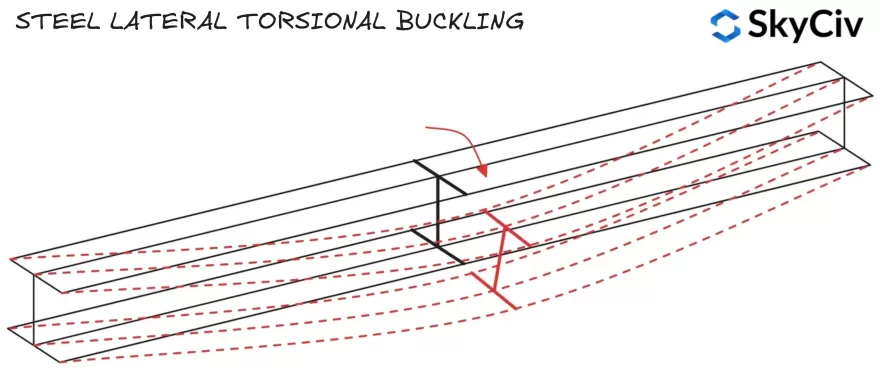
A resistência à flambagem por torção lateral é calculada usando a fórmula abaixo:
\(M_{b,Rd} =x_{LT}*W*f_y/ γ_{M1}\)
Onde W é o módulo da seção plástica (Cpl) para aula 1 & 2 seções, ou módulo de seção elástica (Cele) para aula 3 seções. hLT é um fator de redução para flambagem lateral-torcional, orientação para calcular este fator é fornecida em EN 1993-1-1 Cláusula 6.3.2.2 e 6.3.2.3.
Flange de compressão
Os membros falham na flambagem lateral-torcional quando o banzo de compressão gira e se desloca lateralmente. Se o banzo comprimido de um elemento estiver suficientemente restringido, não será suscetível à flambagem torcional lateral (Consulte PT 1993-1-1 Cláusula 6.3.2.1(2)). As localizações dos flanges de compressão para seções padrão sob carregamento vertical são mostradas abaixo.
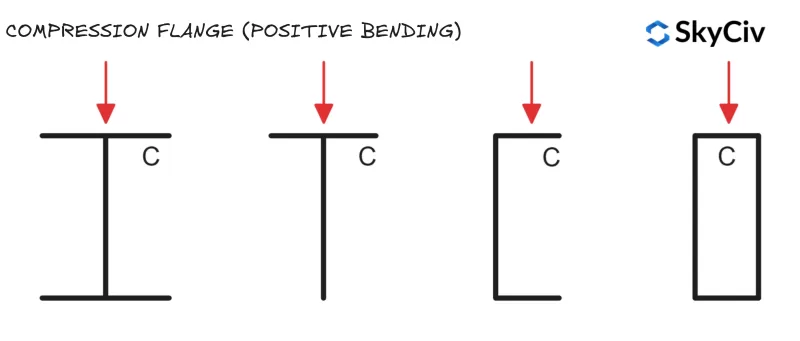
Seções Circulares Ocas (CHS) e seções ocas quadradas (SHS) não são suscetíveis à flambagem torcional lateral, pois eles têm resistência ao momento de seção igual em torno de ambos os eixos (o que significa que o deslocamento lateral e a rotação não afetam a resistência à flexão do membro).
Fator de redução de flambagem de torção lateral
hLT é calculado em EN 1993-1-1 usando qualquer uma das seções 6.3.2.2 (Caso geral) ou seção 6.3.2.3 (Seções laminadas ou seções soldadas equivalentes). Seção 6.3.2.3 é aplicável a todos “padrão” seções e formas (incluindo seções ocas) e seus equivalentes soldados. Seção 6.3.2.2 é aplicável a qualquer seção que não caia na categoria anterior, incluindo seções fabricadas e construídas personalizadas.
Seção 6.3.2.2 usa equação 6.56 Para cálculo da redução de flambagem lateralLT enquanto seção 6.3.2.3 usa equação 6.57. A SkyCiv UM 1993-1-1 Design de Membro de Aço O módulo segue a lógica descrita abaixo para aplicar a equação 6.56 e 6.57.
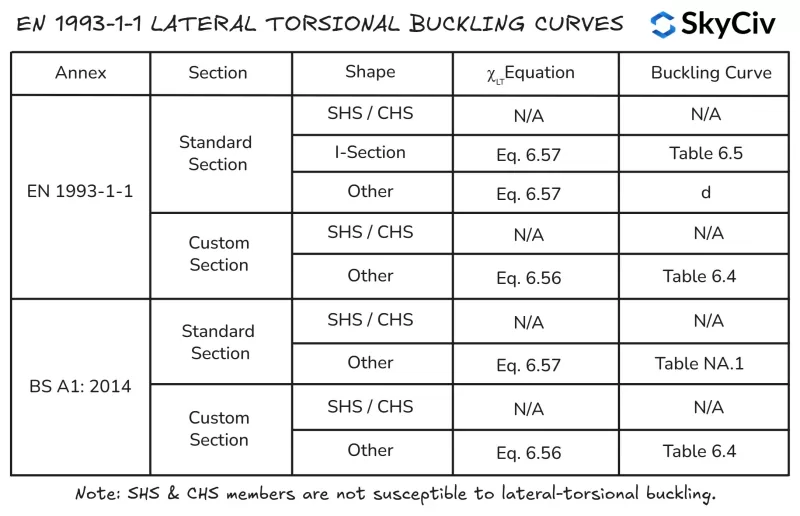
Resistência à flambagem por flexão de eixo menor
A capacidade de flexão de um membro dobrado em torno do seu eixo menor é igual à resistência da seção do eixo menor em torno desse eixo.. A capacidade da seção do eixo menor é a capacidade mínima que uma seção pode atingir em relação a qualquer eixo, portanto, o membro não pode girar deste eixo para uma orientação menos favorável.
Cálculo da resistência à flexão de membro em EN 1993-1-1 Design de Membro de Aço
A SkyCiv UM 1993-1-1 Design de Membro de Aço tool calcula realiza cálculos de resistência à torção lateral de acordo com EN 1993-1-1 Cláusula 6.3.2.2 e Cláusula 6.3.2.3, dependendo do formato da seção e do Anexo Nacional aplicado. Os usuários também têm a opção de especificar um membro como tendo “Restrição Torcional Contínua” que ignorará automaticamente todas as verificações de encurvadura lateral-torcional. Cálculos de resistência à flambagem por torção lateral para um 254 de 5000 mm de comprimento×102 Você pode encontrar uma variedade de tipos de conexão que atendem às suas necessidades sem lidar com sistemas de interface do usuário confusos que exigem uma curva de aprendizado íngreme até mesmo para começar 28 estão detalhados abaixo.

compressão
Resistência à Flambagem por Flexão
A resistência à flambagem por compressão de uma barra também é afetada pelo seu comprimento e rigidez lateral.. Irrestrito, membros mais longos provavelmente falharão devido à encurvadura por flexão antes da seção (abóbora) a capacidade é atingida. EN 1993-1-1 Cláusula 6.3.1.3 fornece orientação sobre o cálculo da resistência à flambagem por flexão de membros para Classe 1, 2 & 3 cruzamentos:
\(N_{b,Rd} = x*A*f_y/ γ_{M1}\)
Onde χ é um fator de redução para flambagem por flexão. A orientação para o cálculo deste fator é fornecida em EN 1993-1-1 Cláusula 6.3.1.3. Fa capacidade lexural deve ser verificada em ambos os eixos para encontrar o valor governante para o membro.
Cálculo da resistência à flambagem por flexão em EN 1993-1-1 Design de Membro de Aço
A SkyCiv UM 1993-1-1 Design de Membro de Aço A ferramenta calcula a resistência à flambagem por flexão em torno de ambos os eixos principais com base nos comprimentos de restrição e nos fatores de comprimento efetivo especificados pelo usuário. Resistência à flambagem por flexão de um 254×102 Você pode encontrar uma variedade de tipos de conexão que atendem às suas necessidades sem lidar com sistemas de interface do usuário confusos que exigem uma curva de aprendizado íngreme até mesmo para começar 28 com comprimento irrestrito de 6.000 mm e 5.000 mm nos eixos Z e Y (respectivamente) estão detalhados abaixo.

Resistência à flambagem torcional-flexural
Seções transversais abertas também são suscetíveis à encurvadura por torção-flexão, que pode ser menor que a resistência do membro à encurvadura por flexão. Seções Circulares Ocas (CHS) e seções ocas quadradas (SHS) os membros não são suscetíveis à flambagem por torção-flexão. EN 1993-1-1 Cláusula 6.3.1.4 fornece orientação sobre o cálculo da resistência à flambagem por flexão e torção do membro:
\(N_{bT,Rd} = χ_T*A*f_y/ γ_{M1}\)
Onde hLT é um fator de redução para flambagem torcional-flexural. A orientação para o cálculo deste fator é fornecida em EN 1993-1-1 Cláusula 6.3.1.3. Fa capacidade lexural deve ser verificada em ambos os eixos para encontrar o valor governante para o membro.
Cálculo da resistência à flambagem torcional-flexural em EN 1993-1-1 Design de Membro de Aço
A SkyCiv UM 1993-1-1 Ferramenta de projeto de membros de aço calcula a resistência à encurvadura por flexão-torção para seções abertas e fechadas aplicáveis de acordo com EN 1993-1-1 Cláusula 6.3.1.4 com base no comprimento da restrição de compressão no eixo principal conforme especificado pelo usuário. Resistência à flambagem torcional-flexural de um 254×102 Você pode encontrar uma variedade de tipos de conexão que atendem às suas necessidades sem lidar com sistemas de interface do usuário confusos que exigem uma curva de aprendizado íngreme até mesmo para começar 28 com comprimento irrestrito de 6.000 mm são detalhados abaixo.

Software de projeto estrutural SkyCiv
SkyCiv oferece uma ampla gama de softwares de análise estrutural e projeto de engenharia, incluindo:
-
- Eurocódigo 3 Projeto de Aço
- Eurocódigo 9 Design de Alumínio
- Eurocódigo 3 Design de terça
- Eurocódigo 3 Calculadora de grupo de parafusos
- Eurocódigo 3 Calculadora de grupo de solda
- Eurocódigo 2 Calculadora de comprimento de desenvolvimento
- Eurocódigo 2 Calculadora de comprimento de ancoragem
- Eurocódigo 5 Calculadora de design de madeira
- Eurocódigo 3 Calculadora de projeto de andaime
Desenvolvedor de software | Engenheiro estrutural
BEng (Civil), DipEng (Programas)



